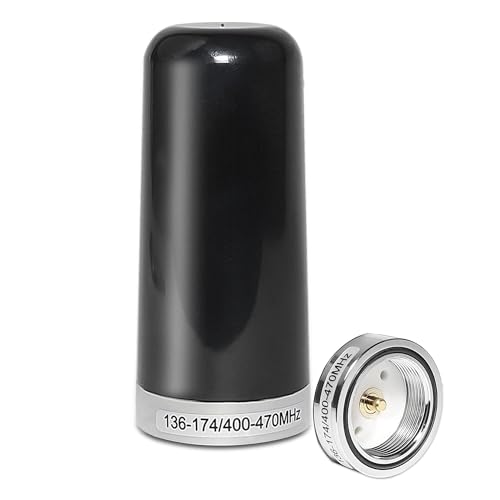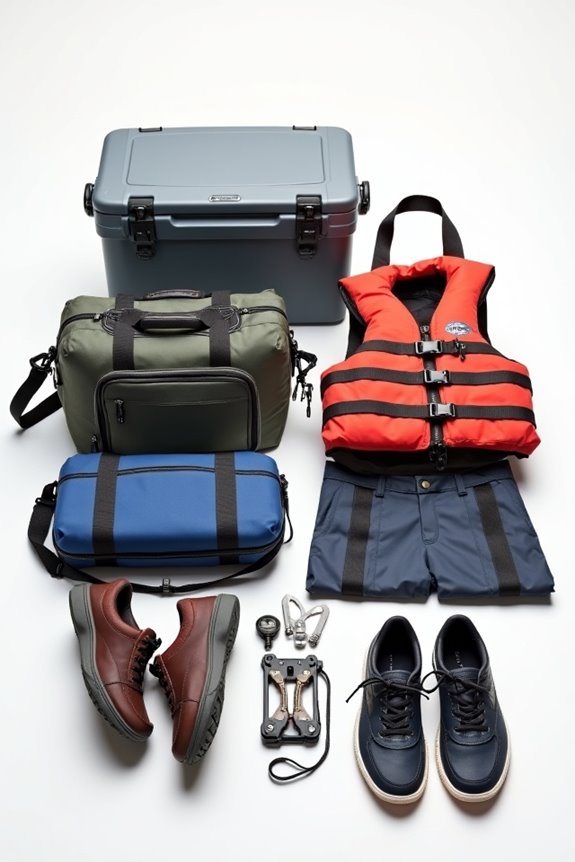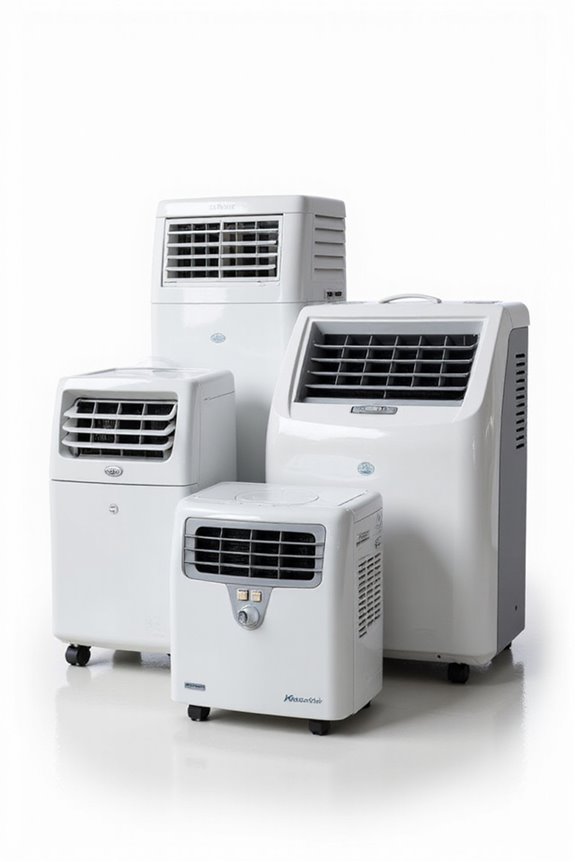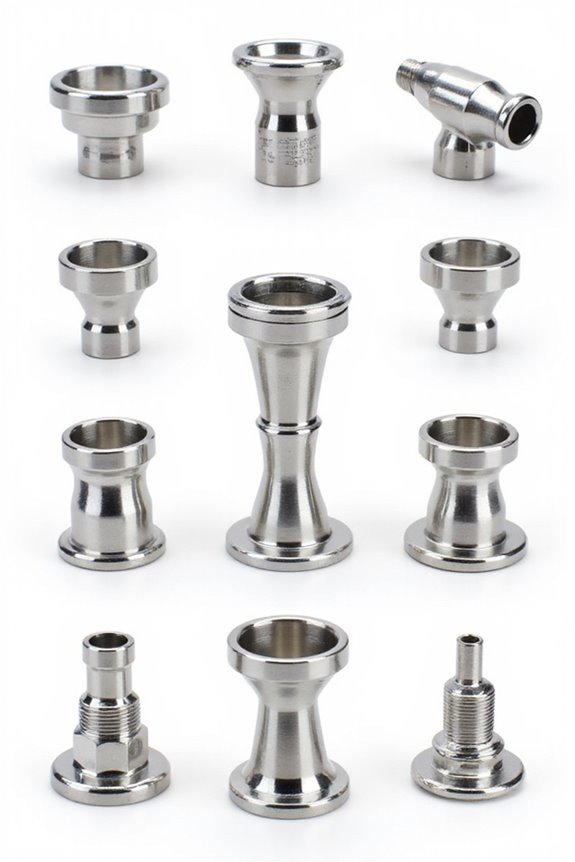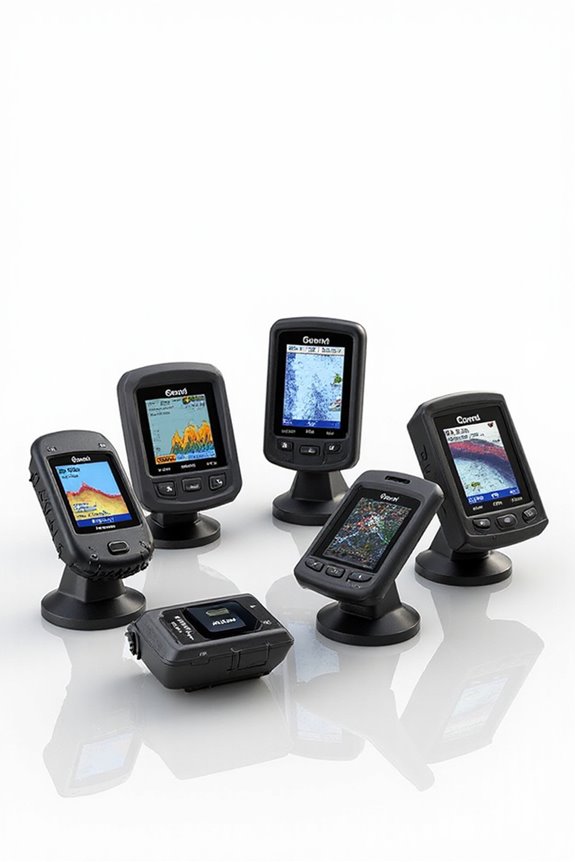As an Amazon Associate, we earn from qualifying purchases. Some links may be affiliate links at no extra cost to you. Although our opinions are based on curated research, we haven't used these products. Articles generated with AI.
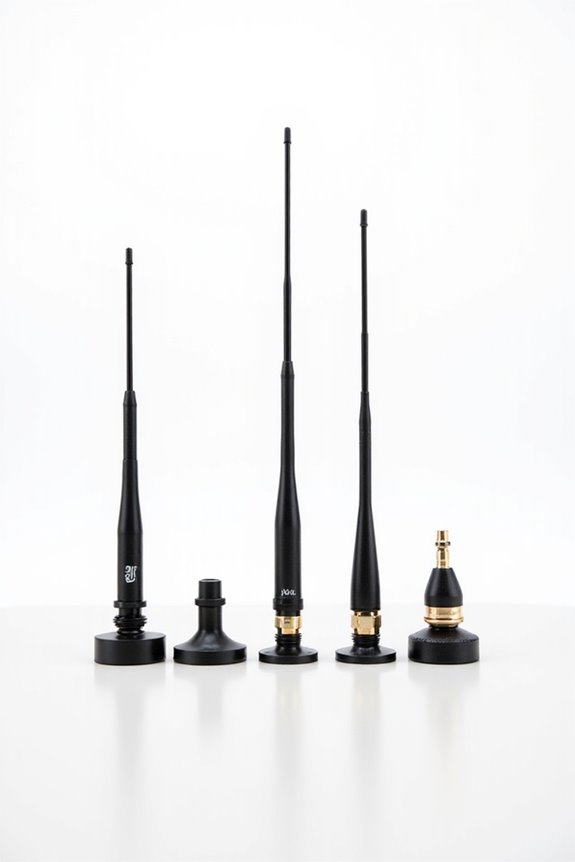
The 5 Best Dual Band Marine Antennas for Crystal Clear Communication at Sea
If you’re looking for crystal clear communication at sea, check out the Bingfu Dual Band VHF/UHF Mobile Antenna for compact performance, or the Anina 3DB Gain GMRS Antenna for reliable range. The HYS Dual-Band NMO Antenna packs a solid build, while the TWAYRDIO NMO Antenna offers ease of setup. Finally, the HYS VHF/UHF Antenna with its magnetic base delivers flexibility. Want to know more about features that enhance your maritime connections?
Key Takeaways
- Gain Performance: Look for antennas with a minimum of 3.0 dBi for VHF and 5.0 dBi for UHF to ensure effective communication range.
- Durable Materials: Opt for antennas made of corrosion-resistant stainless steel to withstand harsh marine conditions and UV exposure.
- Size and Profile: Choose compact models (3.5-9 inches) to minimize wind resistance while ensuring adequate height for better reception.
- Mounting Compatibility: Select antennas compatible with your vessel’s mounting type (NMO or magnetic) to ensure easy installation and reliable performance.
- Omni-directional Design: For moving boats, prefer omni-directional antennas to capture signals from all directions, enhancing communication clarity at sea.
Bingfu Dual Band VHF UHF Mobile Ham Radio Antenna
Bingfu Vehicle Mobile Ham Radio Antenna Dual Band VHF UHF 136-174MHz 400-470MHz Low Profile NMO...
- Frequency Range: VHF 136-174MHz, UHF 400-470MHz
- Antenna Height: 9cm; Direction: Omni-directional;
- Antenna Mounting: NMO Mount;
If you’re an amateur radio enthusiast or someone who loves the thrill of two-way communication, the Bingfu Dual Band VHF UHF Mobile Ham Radio Antenna might just be your new best friend! This compact 9cm antenna offers a frequency range of 136-174MHz for VHF and 400-470MHz for UHF, making it a versatile option for various radio brands. It’s perfect for urban adventures, delivering decent performance on UHF, though VHF might not impress you as much. Plus, at just 4.2 ounces, it won’t weigh your vehicle down. Looking for solid communication? The Bingfu’s got you covered—not bad for a humble antenna, right?
Best For: Amateur radio enthusiasts and urban users seeking a compact and affordable mobile antenna for two-way communication.
Pros:
- Compact and lightweight design makes it easy to install and suitable for vehicles with height restrictions.
- Good performance on UHF frequencies, ideal for urban environments and monitoring operations.
- Compatible with a variety of popular radio brands, enhancing versatility for users.
Cons:
- Poor VHF performance with high SWR readings, limiting its effectiveness for transmitting on VHF.
- Limited transmission range compared to longer antennas, which may affect communication in some situations.
- Not suitable for CB radios, restricting its use to specific amateur and two-way radio applications.
Anina 3DB Gain GMRS Antenna NMO Mount
Anina 3DB Gain GMRS Antenna NMO Mount, Dual-Band UHF VHF 136-174MHz 400-470MHz, 3.5” Antenna NMO...
- Frequency Range: This NMO mount dual band antenna features VHF136-174MHz and UHF 400-470MHz frequency, provides a 2.5 dBi to 3 dBi gain; Ideal solution for your GMRS and...
- Product Dimention: Low-profile GMRS antenna with NMO connection is about 3.5 inches tall and 1.5 inch base diameter; Omni-directional antenna ensures you stay connected...
- Compatible Radios: Perfect replacement antenna for Amateur Mobile Radio, Ham Radio, FRS GMRS Two Way Radio, such as: Kenwood, BTECH, Galaxy Audio, Pro Trucker, Stryker,...
The Anina 3DB Gain GMRS Antenna NMO Mount stands out as an ideal choice for off-road enthusiasts and marine adventurers alike, thanks to its versatile design. With a frequency range of VHF 136-174MHz and UHF 400-470MHz, this nifty little antenna enhances your communication up to 10 miles with a 20-watt mobile. It’s compact at just 3.5 inches tall, so you won’t have to worry about it getting damaged in tight spots. It’s compatible with various radios, including Kenwood and Midland. Give it a go, and experience better signal strength without breaking the bank! How’s that for solid performance?
Best For: Off-road enthusiasts and marine adventurers seeking a reliable and compact antenna for enhanced communication.
Pros:
- Enhances radio range and signal strength, effective up to 10 miles with a 20-watt mobile.
- Compact and low-profile design prevents damage in tight spaces.
- Compatible with a wide range of radio brands, making it versatile for various uses.
Cons:
- Some users report experiencing defective items, leading to varied performance.
- SWR measurements may not satisfy all users, with values reaching up to 1.8 for GMRS.
- Return process may be necessary for non-functional units, causing inconvenience.
HYS Dual-Band NMO 20 Inch Mobile Antenna with Coax Cable
HYS Amateur Antennas Dual-Band NMO 20 Inch Antenna VHF 144/UHF 430MHz NMO L Shape Mount Mobile...
- Centre Frequency: 144/430;VSWR:< 1.5; Gain: 144MHz (3.0dBi),430MHz(5.0dBi);
- Maximum Power Input-watts:100W; Antenna length :20inch; The flexible whip is stainless steel;
- 144/430Mhz NMO Antenna Work for Motorola Kenwood Icom Vertex Blackbox HYT Hytera Mobile Radios. NMO to PL259 working for so239/uhf female Dual Band Radio.
Looking for an affordable yet reliable antenna for your marine adventures? The HYS Dual-Band NMO 20 Inch Mobile Antenna is a fantastic choice. It operates on VHF 144MHz and UHF 430MHz frequencies, giving you solid communication coverage. With a gain of 3.0dBi at 144MHz and 5.0dBi at 430MHz, you’ll enjoy good signal quality, even in rough waters. Weighing just over a pound and made of flexible stainless steel, it’s easy to handle. Just keep in mind, you may need to drill a small hole for installation. Still, it’s a worthy addition to any vessel without breaking the bank!
Best For: Those seeking an affordable and reliable mobile antenna for VHF and UHF communication, especially during marine activities.
Pros:
- Inexpensive, offering good value for the performance.
- Solid build quality that withstands various environments.
- Versatile, compatible with numerous mobile radio brands.
Cons:
- Quarter wave design may limit some performance aspects.
- Poor mounting solution can complicate installation.
- Pre-attached coax end requires drilling larger holes or modifications.
TWAYRDIO NMO Dual Band Antenna for Two Way Radios
TWAYRDIO NMO Dual Band Antenna, 144MHz VHF and 430MHz UHF Two Way Antenna for Motorola Kenwood Icom...
- [Mobile Radio Antenna Frequency] The antenna features VHF UHF of 144/430 MHz (136-174MHz and 400-470Mhz) with VSWR less than 1.5.
- [Great Specifications] The antenna features great specifications with vertical polarization and gain: 144MHz (3.0dBi), 430MHz(5.0dBi) for better TX and RX. The maximum...
- [Premium Material] This 20inch or 51cm tall antenna is composed of stainless steel making it durable and lightweight with a weight of 160g. The NMO mobile transceiver...
When it comes to trusting your communication on the water, the TWAYRDIO NMO Dual Band Antenna stands out as an excellent choice for marine enthusiasts and two-way radio users. This 20-inch beauty operates on 144MHz VHF and 430MHz UHF frequencies, ensuring crystal-clear communications. With a solid gain of 3.0dBi at VHF and 5.0dBi at UHF, you’ll enjoy impressive range—some users report access to repeaters over 30 miles away! Weighing just 6.7 ounces, its stainless steel construction offers durability without bulk. Plus, installation’s a breeze with no tuning required—just mount it, and you’re good to go. Who doesn’t love easy solutions?
Best For: Marine enthusiasts and two-way radio users seeking a reliable and easy-to-install antenna for clear communication.
Pros:
- Compact design with a lightweight stainless steel construction.
- Impressive gain of 3.0dBi for VHF and 5.0dBi for UHF, ensuring excellent range.
- Installation requires no tuning, making it user-friendly.
Cons:
- NMO magnetic base is not included in the package.
- Compatibility limited to specific radio brands, which may not include all devices.
- Performance may vary based on environmental conditions and radio settings.
HYS Dual-Band VHF/UHF Antenna with Magnetic Base
HYS Amateur Pre-Tuned Dual-Band VHF/UHF Dual Band NMO Antenna for 2m 70cm Mobile Radios W/Magnetic...
- Centre Frequency: 144/430;VSWR:< 1.5; Gain: 144MHz (3.0dBi),430MHz(5.0dBi);
- Maximum Power Input-watts:100W; Antenna length :20inch; The flexible whip is stainless steel;
- 144/430Mhz NMO Antenna Work for Motorola Kenwood Icom Vertex Blackbox HYT Hytera Mobile Radios. NMO to PL259 working for so239/uhf female Dual Band Radio.
If you’re on the lookout for a reliable antenna that won’t let you down on the water, the HYS Dual-Band VHF/UHF Antenna with Magnetic Base stands out as a top choice for marine enthusiasts. This 20-inch flexible stainless steel whip not only boasts impressive gains of 3.0 dBi at 144 MHz and 5.0 dBi at 430 MHz, but also supports a maximum power input of 100W. With its strong magnetic base, you’ll appreciate how it holds tight, even at high speeds. Plus, its easy plug-and-play installation means you’ll be set up in no time, ready to communicate crystal clear.
Best For: The HYS Dual-Band VHF/UHF Antenna is best for marine enthusiasts and amateur radio operators seeking reliable communication on the water and beyond.
Pros:
- Strong magnetic base offers a secure grip, even at high speeds.
- Flexible stainless steel whip provides durability and easy handling.
- Impressive gain performance at both 144 MHz and 430 MHz frequencies.
Cons:
- Some users reported minor cosmetic flaws, such as chips and scratches on the base.
- A few users suggested that a longer whip might improve tuning across the 2M band.
- Tuning may be necessary for optimal performance, according to some customer feedback.
Factors to Consider When Choosing a Dual Band Marine Antenna
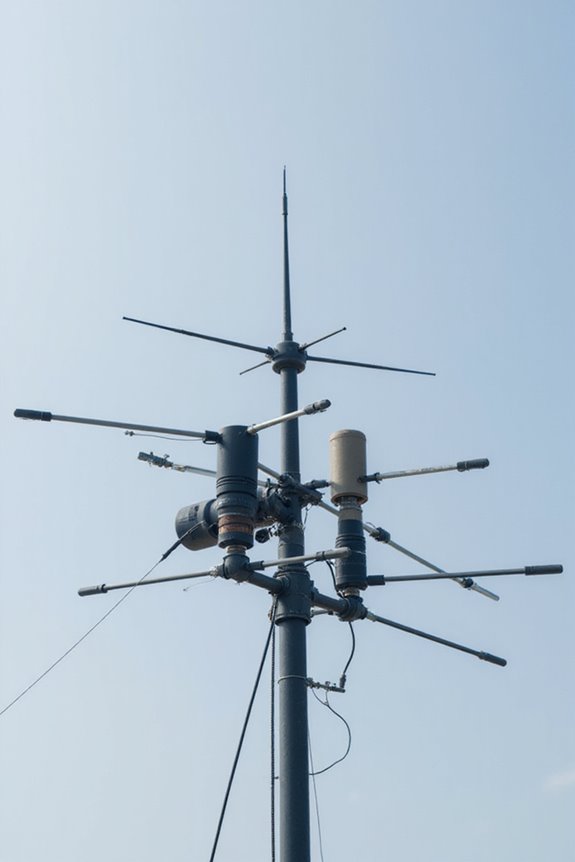
When you’re picking a dual-band marine antenna, you’ll want to take into account several key factors to make sure it meets your needs. Think about the frequency range, antenna gain, and how well it’ll mount on your boat. Plus, don’t forget about material durability and size—nobody wants a giant antenna taking up precious space!
Frequency Range Options
Choosing the right frequency range for your dual band marine antenna can feel a bit like picking a playlist for a road trip—you want the perfect mix to keep communication clear and reliable. A solid option typically includes both VHF (136-174 MHz) and UHF (400-470 MHz) bands, giving you versatile coverage. Why’s that important? Well, in the unpredictable marine environment, clear signals can be a lifesaver. So, whether you’re using FRS, GMRS, or other maritime channels, aligning your antenna’s range with your needs is crucial. Plus, matching it with your equipment helps minimize that pesky SWR—nobody wants to deal with static when they can be chatting smoothly. Remember, a well-chosen frequency range guarantees smoother sailing!
Antenna Gain Considerations
After you’ve zeroed in on the right frequency range for your dual band marine antenna, it’s time to evaluate antenna gain. Think of gain as the power behind your signal. It’s measured in decibels (dBi), and higher values usually mean better range and strength. For instance, if you see 3.0 dBi at VHF and 5.0 dBi at UHF, that’s a sweet deal for UHF performance. Most marine antennas range from 2.5 to 3 dBi, which balances your VHF and UHF needs nicely. But don’t forget about VSWR! A lower VSWR (under 1.5) guarantees you’re getting maximum efficiency. Picking the right gain for your communication needs could be your ticket to clearer conversations at sea!
Mounting Compatibility
While you might be tempted to focus solely on performance specs, mounting compatibility is essential when selecting a dual band marine antenna. You’ll want an antenna that fits your vessel’s mounting type, whether it’s an NMO or magnetic base. Ever tried fitting square pegs in round holes? Not fun! Consider the size and weight of the antenna too, especially if space is tight. Don’t forget to check its frequency range; it should support both VHF and UHF for peak communication. Also, fight the urge to underpower your setup—opt for an antenna that can handle around 100 watts. Finally, look for omni-directional options that provide better reception from multiple directions. Your boat deserves clear communication at sea!
Material Durability
When you’re out on the open water, having a dual band marine antenna that can withstand the elements is essential. You’ll want materials that resist corrosion, like stainless steel, which is a top choice for durability. Flexible antennas are also great because they can bend in high winds without breaking—exactly what you need during those rough sea days! Plus, lighter materials often suit smaller boats or tight spaces better. Don’t forget about UV resistance; if your antenna can’t handle sunlight, it won’t last long. A well-constructed antenna maintains its shape over time, meaning fewer replacements and more seamless communication. So, invest wisely, and keep those channels clear! Who needs static when you’re at sea?
Size and Profile
Choosing the right size and profile for your dual band marine antenna can make a world of difference in performance. While shorter antennas might save space, they often limit your range. You wouldn’t want to miss a critical call because your antenna couldn’t pick it up, right? Those compact models, about 3.5 to 9 inches tall, are great for reducing wind resistance but check if they fit your vessel. Remember, an antenna’s height affects its radiation pattern; more height usually means better reception. If you have a small boat or face height restrictions, consider lower-gain options rated between 2.5 dBi and 3 dBi. Just make sure it doesn’t block your other equipment—no one likes an unexpected obstacle out at sea!
Omni-directional vs. Directional
Understanding the differences between omni-directional and directional antennas can feel a bit like traversing uncharted waters, but it’s essential for getting the best performance from your dual band marine setup. If you want signals from every direction, an omni-directional antenna is your best bet; it’s perfect for boats always on the move! On the other hand, if you’ve got a stationary setup or need to communicate over long distances, a directional antenna sharpens your focus, boosting signal strength. Just keep in mind, though, it requires careful positioning. Think about your sailing habits: do you anchor often, or steer through various channels? Selecting the right antenna can dramatically enhance your communication quality, so choose wisely!
Weather Resistance Features
Your dual band marine antenna should be a reliable partner in tackling tough weather conditions, so it’s a big deal to look for solid weather resistance features. Ideally, you want materials that resist corrosion, like stainless steel or high-grade plastics, because the ocean’s salt can be brutal. Plus, antennas with UV-resistant coatings fight off sun damage—no one wants a faded, flaky antenna! Water ingress protection is key, too; look for sealed designs that keep moisture out of sensitive components. And let’s not overlook flexibility—whip designs can bend without snapping like a twig in a storm. Overall build quality, from reinforced mounts to strong connections, guarantees your antenna will stick around for the ride.
Performance in Various Conditions
When it comes to your marine adventures, the performance of your dual band antenna can make a world of difference, especially when the waves start to kick up. You’ll want to know that VHF can sometimes outshine UHF, or vice versa, depending on your chosen model. Consider antennas with a gain between 2.5 dBi and 5.0 dBi for a stronger signal, ensuring clearer communication, even in choppy waters. A low Standing Wave Ratio, ideally below 1.5, means less signal loss—who wants that? Also, remember longer antennas typically help with reception. And, don’t forget the installation method! Whether you opt for NMO mounts or magnetic bases, stability is key during those wild marine moments. Happy sailing!
Frequently Asked Questions
How Do I Properly Mount a Marine Antenna?
Mounting a marine antenna might sound tricky, but it’s pretty straightforward! First, find a spot high and clear of obstructions. You don’t want any pesky interference. Use sturdy brackets and screws to secure it, making sure it’s vertical; that’ll help with reception. You’ll want to keep the cable run as short as possible—nobody likes a tangled mess! Plus, remember to check your connections periodically—no one enjoys unexpected surprises while out at sea!
What Is the Ideal Height for a Marine Antenna Installation?
You won’t believe how important antenna height is for crystal-clear communications! Ideally, you want to mount your marine antenna at least 15 to 30 feet above the water. This height guarantees a broader signal reach, reducing pesky obstructions. Remember, though, your boat’s radar might get a bit jealous! Keep stability and weight distribution in mind, too. After all, you want to communicate seamlessly without toppling overboard into a sea of confusion!
How Often Should I Check My Marine Antenna’s Condition?
You should check your marine antenna’s condition about once a month—even if it seems fine! Look for signs of wear, like frayed cables or rust. After a rough trip, give it a quick once-over. Remember, a tiny issue could mean big communication problems. Think of it like checking your tire pressure before a road trip; a little maintenance goes a long way. Keep your adventures smooth, and don’t ignore the small stuff!
Can I Use a Dual Band Antenna With My Single Band Radio?
Absolutely, you can use a dual band antenna with your single band radio! It’s like getting a versatile Swiss Army knife for your communication needs. The antenna will work just fine, but you might not take full advantage of its capabilities. Just remember, if your radio’s tuned for a single band, you’ll only be accessing part of what the antenna offers. So, strap it on and enjoy improved reception, even if you’re not maximizing it!
What Type of Coaxial Cable Is Best for Marine Antennas?
You might think any coaxial cable will do, but trust me, quality matters! For marine antennas, a low-loss cable like RG-213 or LMR-400 is your best bet. These options minimize signal loss over long distances, which is critical on the water. While it could be tempting to save a buck, investing in good cable means clearer communication when you need it most. After all, no one wants to play ‘guess what we said’ at sea!


